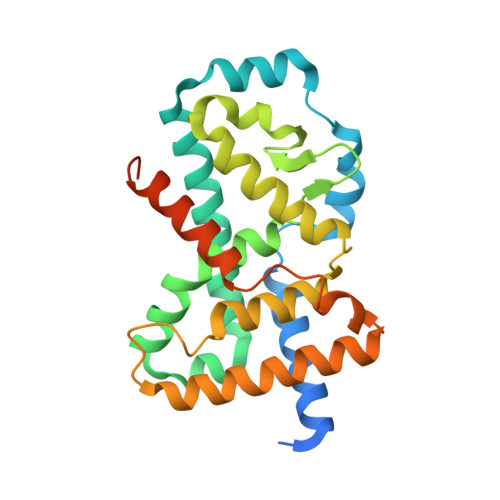Structure-based Discovery of Phenyl (3-Phenylpyrrolidin-3-yl)sulfones as Selective, Orally Active ROR gamma t Inverse Agonists.
Duan, J.J., Lu, Z., Jiang, B., Stachura, S., Weigelt, C.A., Sack, J.S., Khan, J., Ruzanov, M., Galella, M.A., Wu, D.R., Yarde, M., Shen, D.R., Shuster, D.J., Borowski, V., Xie, J.H., Zhang, L., Vanteru, S., Gupta, A.K., Mathur, A., Zhao, Q., Foster, W., Salter-Cid, L.M., Carter, P.H., Dhar, T.G.M.(2019) ACS Med Chem Lett 10: 367-373
- PubMed: 30891142
- DOI: https://doi.org/10.1021/acsmedchemlett.9b00010
- Primary Citation of Related Structures:
6NX1, 6O98 - PubMed Abstract:
A new phenyl (3-phenylpyrrolidin-3-yl)sulfone series of RORγt inverse agonists was discovered utilizing the binding conformation of previously reported bicyclic sulfonamide 1 . Through a combination of structure-based design and structure-activity relationship studies, a polar set of amides at N 1-position of the pyrrolidine ring and perfluoroisopropyl group at para -position of the 3-phenyl group were identified as critical structural elements to achieve high selectivity against PXR, LXRα, and LXRβ. Further optimization led to the discovery of (1 R ,4r)-4-(( R )-3-((4-fluorophenyl)sulfonyl)-3-(4-(perfluoropropan-2-yl)phenyl)pyrrolidine-1-carbonyl)cyclohexane-1-carboxylic acid ( 26 ), which displayed excellent selectivity, desirable liability and pharmacokinetic properties in vitro , and a good pharmacokinetic profile in mouse. Oral administration of 26 demonstrated dose-dependent inhibition of IL-17 production in a mouse IL-2/IL-23-induced pharmacodynamic model and biologic-like efficacy in an IL-23-induced mouse acanthosis model.
- Research and Development, Bristol-Myers Squibb Company, Princeton, New Jersey 08543-4000, United States.
Organizational Affiliation:

















